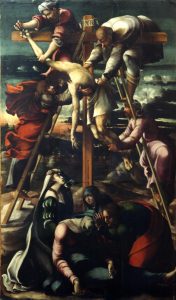TREASURES OF OZIERI
History, culture and nature in the heart of Sardinia.
History, culture and nature in the heart of Sardinia
Ozieri is a town situated in a favourable hilly position on a wide plain where human labour coexists with still unspoilt nature.
The environment, monuments and architectural peculiarities of the historical centre of Ozieri bear witness to a culture that was already distinguished in the Neolithic period, 5,000 years ago, with the important settlement of the Grotte di S.Michele (St Michael’s Caves), a destination for many visitors. The site is considered the cradle of a civilisation, where evolved men were the protagonists of what is known as the Neolithic revolution. The first villages were established during this period, and agriculture and animal husbandry came to life. The finely decorated vases characterised what is considered the first and most important pre-Nuragic Sardinian civilisation: the Culture of Ozieri (3,500-2,900 B.C.)
The artefacts and famous vases, such as the well-known ‘pyxis’, are displayed in the local Archaeological Museum. Housed in the characteristic Old Convent of the Poor Clares, the museum presents interesting finds, bronzes, and a copious numismatic collection.
Ozieri, with its 120 nuraghi, some of which are majestic and imposing in the area, represents an important stronghold of the Nuragic civilisation, which is also testified by the findings of the treasure with two ox-hide ingots, the bronze workshop with a kiln and numerous matrices, about 90 pieces including axes and swords, the askoid vases and the bronze statuette The Boxer. The bronzetto from Ozieri is the most faithful representation of the ‘boxer’ giants found at Monte ‘e Prama, compared to the three bronzettos known to date.
The area has numerous archaeological sites: Domus de Janas, Tombs of the Giants, Dolmens, Sacred Wells. Among the nuraghi in particular, the Nuraghe Burghidu is a remarkable example with its complex three-tower structure that still towers over the surrounding plain. For the Roman period, not to be missed is the Pont’ezzu, a bridge still in good condition that was used until the 1950s.
Thousands of tourists visit the Romanesque Basilica of S.Antioco di Bisarcio (12th century) every year, one of the most important and best preserved in Sardinia. Of interest is the museum system that, in addition to the Archaeological Museum, includes the Museum of Sacred Art with precious exhibits such as the 16th-century retables of the so-called Maestro di Ozieri, the Museum of the Art of Milling and Breadmaking, the Documentation Centre of the Sardinian Language, the Old Convent of San Francesco, and the Open-air Museum of Contemporary Art with the large ‘Prometheus’ by Aligi Sassu.
The historical centre of Ozieri is characterised by narrow streets, stairways and squares where the typical ‘altane‘ embellishes the ancient palaces of Spanish noble families. Prominent among them is the birthplace of Francesco Ignazio Mannu, theauthor of the famous Sardinian hymn ‘Procurade e moderare’ known as the Sardinian Marseillaise, remembered by the monument erected in Piazza Cantareddu. Of historical interest are the churches, in particular the Cathedral, the Church of St Lucia (with its precious Gothic sorrowful crucifix) and the Church of the Capuccini where the relics of St Valentine are kept.
From a cultural point of view, Ozieri is regarded in Sardinia as a reference point for Sardinian language, literature, poetry and music. In fact, the Ozieri Prize for Sardinian Literature, musical events, choirs and cantadores are held here, particularly in September, such as the Usignolo della Sardegna, a competition between the most gifted voices of the Canto in re a s’Otieresa.


Ozieri is also known for its substantial livestock production. In the place, 100,000 sheep are bred, a number that makes the area the municipality with the most sheep in Europe. Consequently, Ozieri is the municipality with the largest production of sheep’s milk, which is processed in large industrial dairies. Pecorino romano, medium-aged pecorino, ricotta and caciotta cheeses are exported in large quantities to Europe and the United States. The breeding of selected Frisona and Bruna dairy cattle is highly appreciated. The historical vocation of Ozieri’s livestock fairs dates back to the 18th century. Lately, regional cattle and agri-food exhibitions have been held in the exhibition centre. In particular, the Zootechnical and Agri-food Fair, which takes placein April, is the most important fair for the sector in Sardinia. Of particular interest is the breeding of horses selected for the gallop races at the Hippodrome in the hamlet of Chilivani.
Nature: rare species of flora and fauna
The environment of the Ozieri area is still unspoilt. In the steppes of the plain, recognised as a Site of Community Interest, among thistles, scilla, wild artichokes, orchids and asphodels live autochthonous species that have disappeared in the rest of Italy and are also very rare in Europe, such as the Prataiola Gallina (Pudda campina) and the Occhione. It is also not uncommon to spot Cranes, Storks and Marsh Harriers. These two species have been regularly nesting in the plain in recent years. Among the reptiles, one can spot the rare Sardinian Gongilo (tiligugu) and the Luscengola (rascinafenu).
In the nearby Lake Coghinas, which stretches across the fields with picturesque bends, carp and perch (subject to sport fishing) and numerous water birds live. A real spectacle is the sighting of the rare Osprey, which swoopsover the water to catch fish. Interesting excursions can also be organised in the nearby woods of Monte Littu and Sa Fraigada. An enchanting, cool landscape where you can find water sources prized for their lightness, the home of rare species such as the Sardinian Goshawk and the Quercino.
